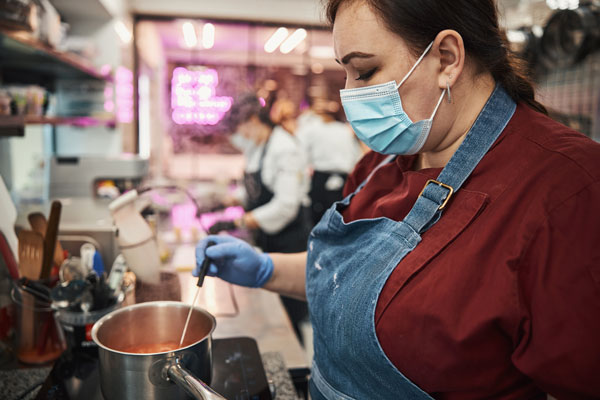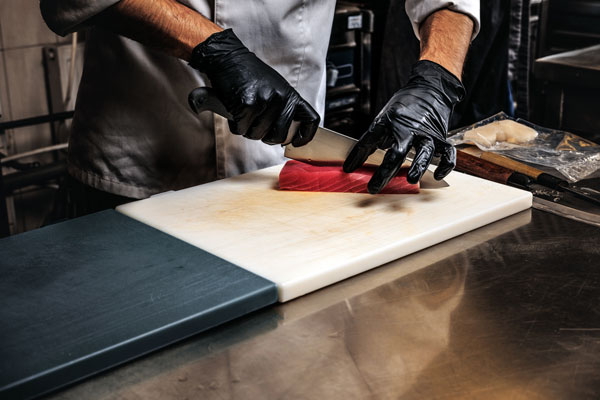Maintaining your Equipment: Is it the Missing Ingredient in your Recipe for Food Safety?
Although I am no longer in day-to-day operations, between our students and foodservice lab at the university and my volunteer activities in my local church, I keep a close hand in food production. This past week, I had the opportunity to lead a group of men at our church in preparation of a luncheon for 100 women who were attending a spirituality retreat. Over the course of the morning, I realized our main cooler in the kitchen was not functioning properly and was about 10˚F above the required temperature. While we do have a commercial kitchen, we do not routinely log temperatures, so when the unit started to malfunction is questionable. Even more concerning was not the lunch we were preparing for, but the dinner that was served the night before for 300+ families in the parish.
I am certain stories like this are commonplace in foodservice operations across the country. I can think of several instances when I was in day-to-day operations that were similar. While we (and I especially through my research focus) tend to focus on employee behavior and developing the culture of food safety we have discussed several times before, including our last blog, the truth is that properly functioning equipment are really the backbone to our food safety plan.
It all starts with our food storage equipment – as soon as food arrives in our restaurant, many items are placed in refrigerated storage. While there are several issues that can arise with coolers that I would not advise you to repair yourself, there are several things we can do to help ensure the units function properly and keep them in peak condition. It doesn’t take any experience to clean; the heavier the use of the unit, the more frequently it should be cleaned. Cleaning the inside and outside with hot soapy water is not only sanitary, but it helps your staff to inspect the units to spot potential issues before they become a major concern. Excess condensation, unusually loud condensers, bad gaskets are all easy to notice and repair if your staff is familiar with the equipment.
With all equipment, visit with your local repair technicians to help you decide on a preventative maintenance program that is right for your business. It is hard to have a clear-cut, adaptable plan for each business since the production and volume of businesses vary so much.
Your food production equipment should also be kept in good condition. While I think we all would like to believe this is done in our operation, when was the last time you calibrated the fryer to ensure it was actually heating to the temperature you believe it should be? What about your oven, range, or grill? Equipment that is too hot will char the outside while leaving the inside raw, while a unit that is too cool while take a longer time to cook the product than what you may have anticipated. Be sure to clean these items, too. While we all know the importance of cleaning food contact surfaces, it is also important to clean the underside, sides, and back of the units to maintain peak performance. A cleaning plan developed for the business should always include these areas and be sure to follow-up with your staff on these items.
Last, but not least, be sure your dishwashing equipment is functioning properly. This has even been more important in the last few years with COVID than it has ever been. Your staff should verify that the machine is operating at the required wash and rinse temperatures often during their shifts. They should also be trained to recognize when equipment is not functioning correctly – and this is something that can be difficult with high staff turnover. I recall one instance in our business where the machine was using a container of detergent every two hours. My first shift dishwasher was new and oblivious top the fact that this was way too much. It wasn’t until later in the day when my night shift employee caught the issue – which had already cost us hundreds of dollars.
With all equipment, visit with your local repair technicians, they can help you decide on a preventative maintenance program that is right for your business. It is hard to have a clear-cut, adaptable plan for each business since the production and volume of businesses vary so much. Most of these companies want to be a good partner for your business because they want to have a long-term relationship with you. Remember a little spent on preventative maintenance each year will help alleviate major repairs down the road and ensure your food is kept safe along the continuum of food production.
In May, we will release the second SafeBites Webinar of 2022, so be on the lookout for it. Be sure to reach out if you have any questions about food safety or have a topic you’d like to learn about in an upcoming SafeBites Webinar or if there is something you’d like me to address through our blogs. Risk Nothing.
READ MORE POSTS
Food Traceability in Foodservice Operations: An Essential, and Soon-to-be Required, Component of your Food Safety Plan
In June, I discussed the importance of having a solid food defense plan, and I provided you some resources for developing or strengthening your food defense plan. As I was writing those blogs, my mind kept turning toward food traceability. While they are distinctly different concepts, food traceability goes hand-in-hand with a food defense program. I would argue for your food defense plan to be effective, you must have an effective internal food traceability program, where you can trace the product back to the supplier (backward traceability), but also be able to trace the product from the supplier to the guest who was served the product (forward traceability).
Food Defense Plan Resources – at just the right price…
Earlier in the month, I discussed the importance of having a solid food defense plan in place for your foodservice operation. Even if the first version of your plan is not perfect, it is a start. Having plans down on paper will force you to think through the process and ensure the vulnerable points where opportunities exist for possible contamination within the operation are mitigated.
Don’t Turn a Blind Eye to Your Food Defense Practices
Late last week, as I mindlessly scrolled through Twitter, I ran across a Tweet suggesting the #IceCreamChallenge from summer 2019 was the real cause of the Coronavirus spread. Of course, the Tweet was made tongue in cheek, but it did cause me to reflect on that challenge, which had a short life on social media in the summer of 2019.
Salmonella and Listeria monocytogenes: Serious Threats to the Safety of Food
Earlier in the month, I mentioned the top microbial enemies we all face in foodservice operations, E. coli, Campylobacter, Salmonella, and Listeria monocytogenes. While we discussed E. coli and Campylobacter, we did not get around to discussing Salmonella or Listeria monocytogenes.










